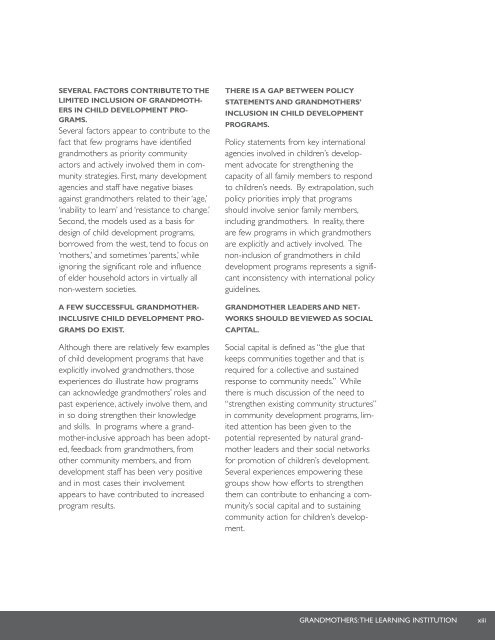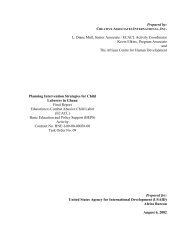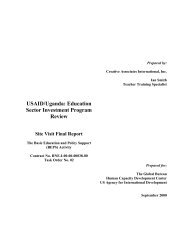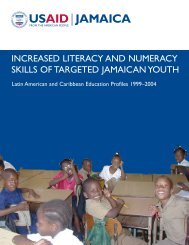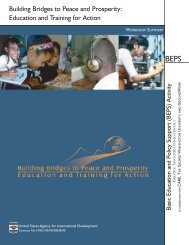THERE IS LIMITED DOCUMENTATION OFGRANDMOTHERS’ ROLES.Analysis <strong>and</strong> documentation of gr<strong>and</strong>mothers’roles in different societies is quite limited.The results of many studies on differentchild development topics either completelyignore, or give minimal attention to,gr<strong>and</strong>mothers’ roles <strong>and</strong> influence at thehousehold level. This can be explained inpart by negative stereotypes of gr<strong>and</strong>mothersheld by many developmentorganizations <strong>and</strong> in part by the narrowmodels used as a basis for data collection.PREVALENT ASSESSMENT METHODOLO-GIES FAIL TO EXAMINE HOUSEHOLDROLES AND RELATIONSHIPS.The methodologies used in formative studieson child development topics mostoften focus narrowly on individual knowledge,attitudes, <strong>and</strong> practices (KAP) ofwomen/mothers. There is a need foralternative assessment methods based ona more systemic, anthropological frameworkthat looks at social structures, roles,<strong>and</strong> relationships in households that influenceattitudes <strong>and</strong> practices related tochild development. In a more systemicapproach, gr<strong>and</strong>mothers’ experience <strong>and</strong>roles at the household level would certainlybe analyzed.GRANDMOTHERS CONTRIBUTE TO CUL-TURAL CONTINUITY.The cultural dimension of developmentprograms has generally been neglected,though there is a growing concern that thisis a dangerous trend that can contribute tothe loss of cultural values <strong>and</strong> identity.<strong>Gr<strong>and</strong>mothers</strong> play a critical role in transmittingcultural values <strong>and</strong> practices toyounger generations, thereby contributingto the maintenance of cultural identity inan increasingly culturally homogeneousworld.GRANDMOTHERS’ PLAY AN INFLUEN-TIAL ROLE IN CHILDREN’S DEVELOP-MENT ACROSS CULTURES.While documentation on gr<strong>and</strong>mothers’roles is relatively limited, the available evidencedoes show that in virtually all nonwesternsocieties in Africa, Asia, LatinAmerica,The Pacific, <strong>and</strong> in indigenous culturesin North America <strong>and</strong> Australia, seniorwomen, or gr<strong>and</strong>mothers, play a centralrole in child-rearing. In all of these societiesthey are looked to as advisors of theyounger generations based on their age<strong>and</strong> experience, though in many cases theirstatus is diminishing. Across cultures thereare a series of core roles played by gr<strong>and</strong>motherswhile at the same time there isconsiderable variability in their culture-specificbeliefs <strong>and</strong> practices.FEW CHILD DEVELOPMENT PROGRAMSEXPLICITLY INVOLVE GRANDMOTHERS.In spite of the fact that gr<strong>and</strong>mothers playa significant role in all aspects of childhealth <strong>and</strong> development at the householdlevel, few child development programshave explicitly identified <strong>and</strong> involved themas key actors. This review analyzes theextent to which they have been involvedin five key program areas related to childdevelopment: early childhood development,primary school education, maternal<strong>and</strong> child health <strong>and</strong> nutrition, childhygiene, <strong>and</strong> HIV/AIDS. It was concludedthat in all of these areas the involvementof gr<strong>and</strong>mothers has been very limited.xiiUNITED STATES AGENCY FOR INTERNATIONAL DEVELOPMENT
SEVERAL FACTORS CONTRIBUTE TO THELIMITED INCLUSION OF GRANDMOTH-ERS IN CHILD DEVELOPMENT PRO-GRAMS.Several factors appear to contribute to thefact that few programs have identifiedgr<strong>and</strong>mothers as priority communityactors <strong>and</strong> actively involved them in communitystrategies. First, many developmentagencies <strong>and</strong> staff have negative biasesagainst gr<strong>and</strong>mothers related to their ‘age,’‘inability to learn’ <strong>and</strong> ‘resistance to change.’Second, the models used as a basis fordesign of child development programs,borrowed from the west, tend to focus on‘mothers,’ <strong>and</strong> sometimes ‘parents,’ whileignoring the significant role <strong>and</strong> influenceof elder household actors in virtually allnon-western societies.A FEW SUCCESSFUL GRANDMOTHER-INCLUSIVE CHILD DEVELOPMENT PRO-GRAMS DO EXIST.Although there are relatively few examplesof child development programs that haveexplicitly involved gr<strong>and</strong>mothers, thoseexperiences do illustrate how programscan acknowledge gr<strong>and</strong>mothers’ roles <strong>and</strong>past experience, actively involve them, <strong>and</strong>in so doing strengthen their knowledge<strong>and</strong> skills. In programs where a gr<strong>and</strong>mother-inclusiveapproach has been adopted,feedback from gr<strong>and</strong>mothers, fromother community members, <strong>and</strong> fromdevelopment staff has been very positive<strong>and</strong> in most cases their involvementappears to have contributed to increasedprogram results.THERE IS A GAP BETWEEN POLICYSTATEMENTS AND GRANDMOTHERS’INCLUSION IN CHILD DEVELOPMENTPROGRAMS.<strong>Policy</strong> statements from key internationalagencies involved in children’s developmentadvocate for strengthening thecapacity of all family members to respondto children’s needs. By extrapolation, suchpolicy priorities imply that programsshould involve senior family members,including gr<strong>and</strong>mothers. In reality, thereare few programs in which gr<strong>and</strong>mothersare explicitly <strong>and</strong> actively involved. Thenon-inclusion of gr<strong>and</strong>mothers in childdevelopment programs represents a significantinconsistency with international policyguidelines.GRANDMOTHER LEADERS AND NET-WORKS SHOULD BE VIEWED AS SOCIALCAPITAL.Social capital is defined as “the glue thatkeeps communities together <strong>and</strong> that isrequired for a collective <strong>and</strong> sustainedresponse to community needs.” Whilethere is much discussion of the need to“strengthen existing community structures”in community development programs, limitedattention has been given to thepotential represented by natural gr<strong>and</strong>motherleaders <strong>and</strong> their social networksfor promotion of children’s development.Several experiences empowering thesegroups show how efforts to strengthenthem can contribute to enhancing a community’ssocial capital <strong>and</strong> to sustainingcommunity action for children’s development.GRANDMOTHERS:THE LEARNING INSTITUTIONxiii
- Page 1 and 2: GRANDMOTHERS:A LEARNING INSTITUTION
- Page 3: GRANDMOTHERS:A LEARNING INSTITUTION
- Page 11 and 12: EXECUTIVE SUMMARYSociety itself fai
- Page 13: Education, the Bernard Van LeerFoun
- Page 17: - Who am I? Assign children to askf
- Page 20 and 21: in educational activities on home t
- Page 22 and 23: “A grandmother’s understandingo
- Page 24 and 25: “Culture tells peoplehow to view
- Page 26 and 27: attention given to grandmothers’
- Page 28 and 29: social work, including family syste
- Page 30 and 31: mation from Azerbaijan (McNulty 200
- Page 32 and 33: “The status of eldersin tradition
- Page 34 and 35: “As women, thegrandmothers haveli
- Page 36 and 37: members often consult the moreexper
- Page 38 and 39: “Social capital is a community’
- Page 40 and 41: In a collaborative effort between
- Page 42 and 43: in-laws and the additional free tim
- Page 44 and 45: "Involving grandmothersin community
- Page 50 and 51: CULTURALLY-ADAPTED EDUCATIONMATERIA
- Page 52 and 53: strated the power of participatory
- Page 54 and 55: effects of the new ideas, their con
- Page 57 and 58: V. GRANDMOTHERS: A LEARNING INSTITU
- Page 59 and 60: Many health and development workers
- Page 61 and 62: VI. RECOMMENDATIONS FORBASIC EDUCAT
- Page 63 and 64: parents themselves did not go to sc
- Page 65 and 66:
community ties by increasing teache
- Page 67 and 68:
of millions. On the other hand, som
- Page 69:
teachers, teacher abuse of children
- Page 73 and 74:
APPENDIX B:ANNOTATEDREFERENCES ON T
- Page 75 and 76:
acceptable for younger women to mak
- Page 77 and 78:
showed that men are not directly in
- Page 79 and 80:
ecause they had more time to devote
- Page 81 and 82:
matrilineal or patrilineal areas
- Page 83 and 84:
diet, work, fetal development, sexu
- Page 85 and 86:
in the family and social networks.
- Page 87 and 88:
elated, for example, to early child
- Page 89 and 90:
REFERENCESAdams, A. M., S. Madhavan
- Page 91 and 92:
BASICS and LINKAGES. 1998. Influenc
- Page 93 and 94:
Childhood Education and Development
- Page 95 and 96:
Krishna, A. and N. Uphoff. June 199
- Page 97 and 98:
Sear, R., R. Mace, and I. A. McGreg
- Page 99 and 100:
ABOUT THE AUTHORThis review was pre


